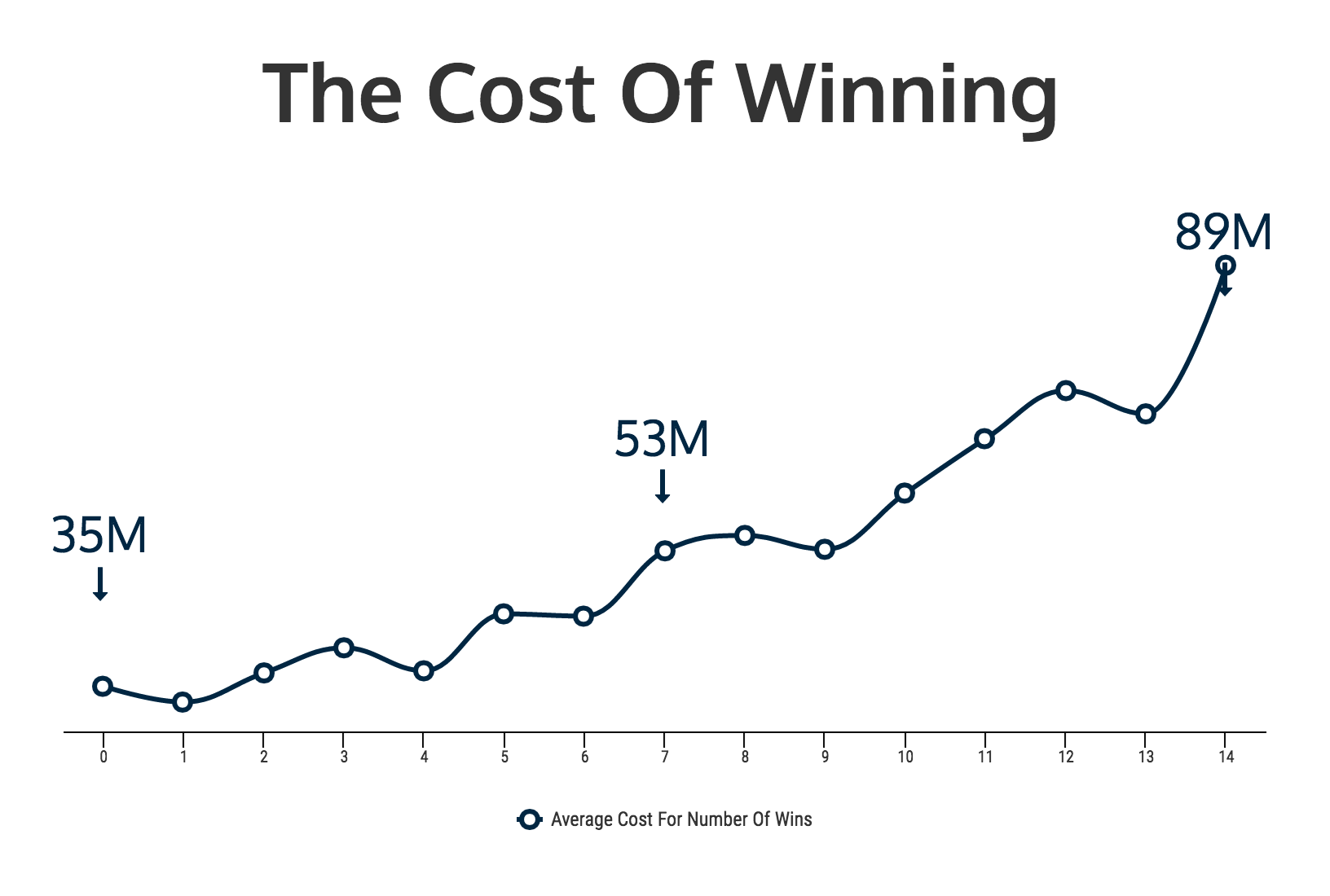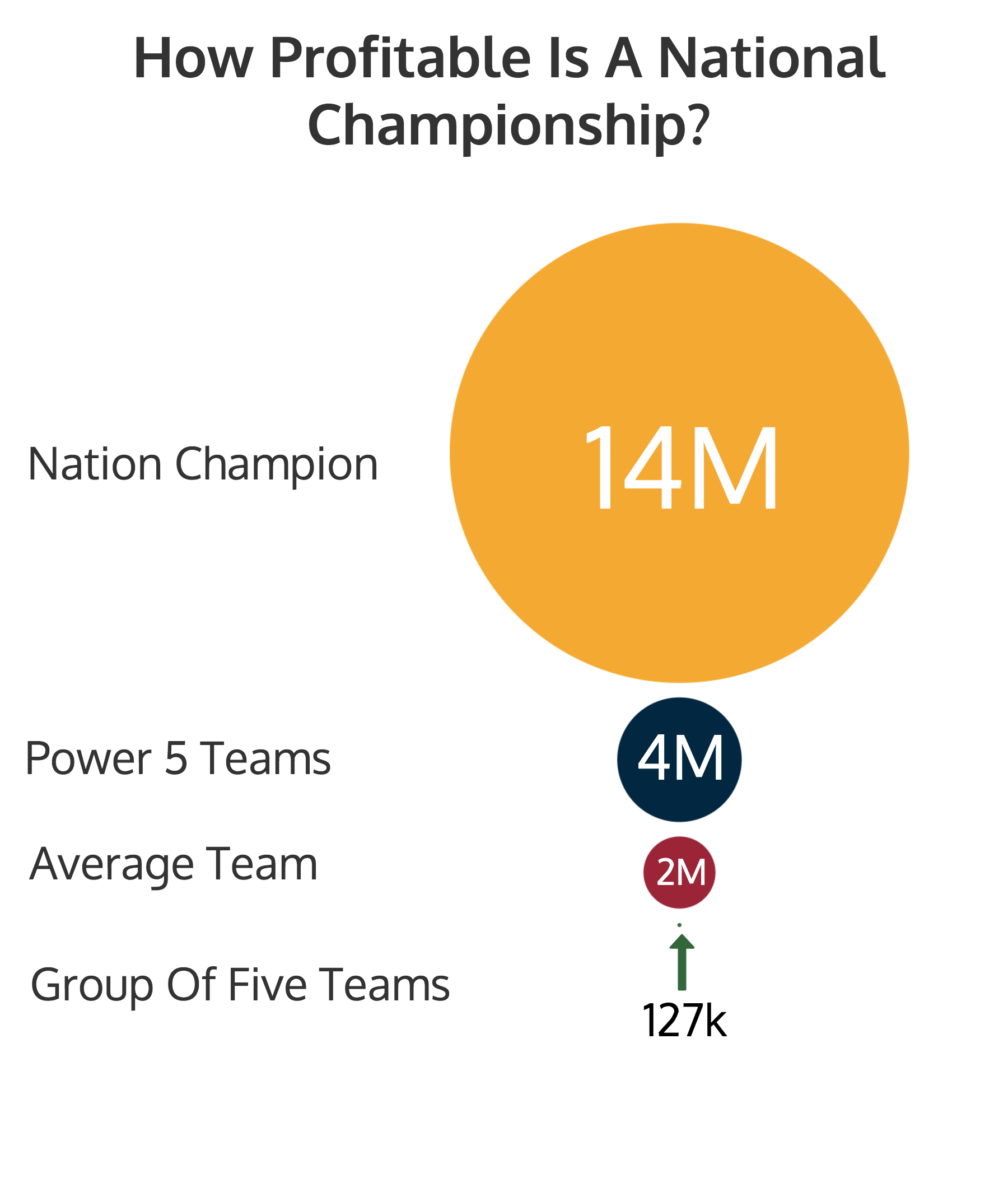We know there is money in college sports, whether it comes directly from the rabid fan bases, the boosters or the massive TV contracts. It may not come from the exact same sports or places for all colleges, but the main belief is there is a lot of cash to go around. Especially when it comes to college football, and that leads us to the ultimate question right now: Can we pay those player? Or college athletes in general?
Now, in a lot of programs, like my alma mater of University of Arkansas, and the other Power Five schools like it, that might be possible. For those 60 or so schools, life is good for their athletic department. They see college football and sports in general as a great way to not only increase their visibility to the country but also make some serious cash. In fact, almost half a BILLION for the 12 SEC teams in 2015 and over $250 million for the 4 other Power conferences.
But what about the other half of the college football landscape that isn’t rolling in the dough? This includes the other 60-ish teams do not have the luxury of lucrative TV deals, billionaire donors or top recruits. These teams are known as the Group of Five conferences, and are like little brothers to the Power Five teams. They line up every Saturday in the fall and often go to battle against teams that have 10x their budget. And they are the ones who would struggle to pay their players, as we will quickly see.
Oh, and that is only for the 125 or so Division 1 schools. We don’t even get into the other levels. Mostly because I don’t think it would be possible for a majority of those to even think about paying players.
So let us take a deep dive into the finances of the many public Division 1 athletic departments. From the uber powerful Alabama, to the newer but also great Appalachian State. We will take you through all parts of winning to see not only how much it costs to run a program but also sometimes the razor thin profit margins. If you think college sports is a cash cow for all schools, you are in for a rude awakening.
Methodology
We selected 100 public universities from this extremely useful data set put together by USA Today. It ranks 231 athletic departments by their profits, revenue and expenses, going back 10 years.
After we pulled all of the financial data provided by the USA Today data set, we then compared that to their football performance. For each year, going back to 2005, we looked at the winning percentage, bowl outcome, coach and other pertinent data was recorded. (If anyone was wondering, we crunched the numbers and Nick Saban is the coach with the most profitable athletic department.)
Then we crunched the numbers to find out what it really took to win championships and even exist as a team. Also, it should be noted that all the calculations and numbers below are for the full athletic department, not just the football teams!
Pay To Play
In the spirit of winning championships, I will start with how much, on average, it costs to play for a national championship. In case anyone has forgotten, the SEC has dominated the national championship picture for the past 10 years. They are also the richest conference in the nation, which could skew the results or just prove how much money it really costs.
Let’s start with the 2006 season: on average the school’s athletic department must be spending almost $100 million per year to win a national championship. The exact number is $98,775,583 a year and in total across 10 years is $1,975,511,660. Or, if you need an easy comparison, the national GDP of Belize or Djibouti.
<img class="aligncenter" src="https://venngage-wordpress.s3.amazonaws.com/uploads/2016/09/df674550-898a-4bb3-a17a-4a9289e10111-2.png" alt="Cost Of A National Football Championship" /> See this <a href="https://venngage.com/blog/paying-college-athletes/">infographic on Venngage</a>.
The teams that win national championships outspend the rest of the pack by a significant margin, doubling the average, quadrupling the Group Of Five teams, and beating the rest of the Power Five teams by $27M a year. Even the lowest spender of all, the 2007 LSU team ($73M), still spent almost $25M more than the average expenses per year. Which is honestly surprising that it was an SEC team that spent the least.
The all important question at the end of the day is, How much does it cost to WIN? We crunched the numbers and this is what we found:
<a title="Infographics: The Cost To Win In College Football | Venngage" href="https://venngage.com/blog/paying-college-athletes/"> <img class="aligncenter" src="https://venngage-wordpress.s3.amazonaws.com/uploads/2016/09/0c3b7ced-108e-4c8a-bde4-c22c47f079da-2.png" alt="The Cost To Win In College Football" /></a> The Cost To Win In College Football | <a style="color: #c7c5c5; text-decoration: none; font-style: italic;" href="https://venngage.com">Infographics </a>
Those who turn in a mediocre season of seven wins still need $53M in the athletic department’s coffers. On the other hand, getting to the pinnacle of 14 wins costs almost double the mediocre teams.
Now let’s take a look at what it takes just to reach a bowl game. Which for a lot of these Group of Five and some Power Five teams is the ultimate goal each season. It makes the fans, boosters, and alumni happy for another season. Even if it is the Famous Idaho Potato Bowl, set in sunny Boise, Idaho in the dead of winter. They still receive a payout of 750k per team which is nothing to scoff at.
Here is what it costs the athletic departments to go to a bowl game each year, broken down for both the winners and losers:
<a title="Infographics: The Cost Of A Going Bowling | Venngage" href="https://venngage.com/blog/paying-college-athletes/"> <img class="aligncenter" src="https://venngage-wordpress.s3.amazonaws.com/uploads/2016/09/d0810aa6-b7f6-450e-8d1a-902898fe515e-2.png" alt="The Cost Of A Going Bowling" /></a> The Cost Of A Going Bowling | <a style="color: #c7c5c5; text-decoration: none; font-style: italic;" href="https://venngage.com">Infographics</a>
There is nothing too surprising here, except that some schools are spending almost triple the sample average to get to a bowl game. It is comforting to see that the average expenses for bowl-bound teams are relatively close to the sample average.
After seeing the very high $154M count from above, it piqued my interest in seeing how many athletic departments spent close to that each year. And to my surprise, almost all of the programs spent less than $75M:
<a title="Infographics: Who Spends What In College Football | Venngage" href="https://venngage.com/blog/paying-college-athletes/"> <img class="aligncenter" src="https://venngage-wordpress.s3.amazonaws.com/uploads/2016/09/2aeb3187-a7fb-4b48-a69e-1beb8dddf51b-3.png" alt="Who Spends What In College Football" /></a> Who Spends What In College Football | <a style="color: #c7c5c5; text-decoration: none; font-style: italic;" href="https://venngage.com">Infographics </a>
The average amount spent per year by the athletic departments has DOUBLED in the past 10 years, having started at about $33M in 2005, and having ballooned to over $66M in 2015:
<a title="Infographics: Expenses Are Exploding In College Football | Venngage" href="https://venngage.com/blog/paying-college-athletes/"> <img class="aligncenter" src="https://venngage-wordpress.s3.amazonaws.com/uploads/2016/09/6c7df7ac-f5a6-4b14-93e6-0e87654473cd-1.png" alt="Expenses Are Exploding In College Football" /></a> Expenses Are Exploding In College Football | <a style="color: #c7c5c5; text-decoration: none; font-style: italic;" href="https://venngage.com">Infographics </a>
This is how all that money is spent on average across all teams:
<a title="Infographics: How Money Is Spent In College Football | Venngage" href="https://venngage.com/blog/paying-college-athletes/"> <img class="aligncenter" src="https://venngage-wordpress.s3.amazonaws.com/uploads/2016/09/8311cd63-d4d9-43e0-a5c0-c9de3a08e4de-3.png" alt="How Money Is Spent In College Football" /></a> How Money Is Spent In College Football | <a style="color: #c7c5c5; text-decoration: none; font-style: italic;" href="https://venngage.com">Infographics </a>
Is it surprising to anyone that the coaching staff takes up more than a third of all expenses? Especially when, in a majority of states, the highest paid public employee is the head football or basketball coach. The most troubling thing we saw is that scholarships do not take up a bigger chunk of that pie, but that is an argument for a different day. Or later in this article.
Finally, here is the all-important breakdown of spending by conference for the past ten years, with the Power Five teams continuing to outspend the other teams by a large factor:
<a title="Infographics: Average Expenses By Conference In College Football | Venngage" href="https://venngage.com/blog/paying-college-athletes/"> <img class="aligncenter" src="https://venngage-wordpress.s3.amazonaws.com/uploads/2016/09/3f5a64a1-9194-4ae1-8bd5-62710c86048c-4.png" alt="Average Expenses By Conference In College Football" /></a> Average Expenses By Conference In College Football| <a style="color: #c7c5c5; text-decoration: none; font-style: italic;" href="https://venngage.com">Infographics </a>
As you can see above, the bottom four conferences combined only outspend the Big Ten by $1M. By this logic, you could fund four separate athletic departments in those conferences for the price of one Big Ten or SEC team. And yet they all play against each other at one time or another. Again, seems fair.
Just Win, Profits Will Follow…Sometimes
Now that we have got through how much it costs to run an athletic department and a winning team, it is time to look at how that benefits the universities. We are talking about massive profits…well, in some cases.
<a title="Infographics: Many Schools Are Losing Money In College Football | Venngage" href="https://venngage.com/blog/paying-college-athletes/"> <img class="aligncenter" src="https://venngage-wordpress.s3.amazonaws.com/uploads/2016/09/6fb75103-db4f-4cb5-ab51-d61be9ea7b2d.png" alt="Many Schools Are Losing Money In College Football" /></a> Many Schools Are Losing Money In College Football | <a style="color: #c7c5c5; text-decoration: none; font-style: italic;" href="https://venngage.com">Infographics </a>
Let’s start with how many teams are running their athletic department at a deficit. Because like we saw above, there is a huge disconnect between earnings for the top and bottom, and even the middle tier schools.
More than one-third of schools across the 10 years of data were operating at a deficit. A third of those in the red operating at more than a $1M difference. And what was most surprising was that some of those spending more than they made were built on winning in college football. These were not only the teams that those powerhouses play as warm up games but also the traditional powerhouses.
Some of these athletic departments are making upwards of $25M in profits for many years in a row. The rich conferences continue to grow richer, which is not always a bad thing especially if your alma mater is one of those teams. Like Arkansas in the SEC. (Oh and if you haven’t noticed by now, the red used in all the graphics in Arkansas Red.)
The goal of any team, no matter the conference is to one day win a national championship. We already saw that is not even feasible from a spending standpoint but is it even worth it? Because if it is costing some departments almost a $100M to put together a winning team, they must be getting something great out of it. Well, other than prestige, and bragging rights for the foreseeable future.
<a title="Infographics: Profits For A National Championship | Venngage" href="https://venngage.com/blog/paying-college-athletes/"> <img class="aligncenter" src="https://venngage-wordpress.s3.amazonaws.com/uploads/2016/09/7f372423-e76e-4d88-b5e7-475541a9cb57.png" alt="Profits For A National Championship" /></a> Profits For A National Championship | <a style="color: #c7c5c5; text-decoration: none; font-style: italic;" href="https://venngage.com">Infographics </a>
So it’s not as profitable as I would have guessed; hopefully the prestige is worth a lot more. Additionally, it is important to remember this profit is from the full athletic department and has to be spread across the entire department, not just the football team.
But the $14M that an average national championship winning athletic department will receive is still 110x more than the average Group Of Five team. It is mind boggling that they are spending, on average, about $25M to receive a few hundred thousand dollars in profits for their school. Even the Power Five profit 32x more than the Group of Five teams.
Again, the only thing that most fans, alumni and boosters care about is winning. So how much does a winning season net your athletic department?
<a title="Infographics: The Spoils Of Winning In College Football | Venngage" href="https://venngage.com/blog/paying-college-athletes/"> <img class="aligncenter" src="https://venngage-wordpress.s3.amazonaws.com/uploads/2016/09/092e562a-9fae-4ae4-adbc-68f90df43a6d-2.png" alt="The Spoils Of Winning In College Football" /></a> The Spoils Of Winning In College Football | <a style="color: #c7c5c5; text-decoration: none; font-style: italic;" href="https://venngage.com">Infographics </a>
Not only those who spend more win more, but they also make more. In this case, the mediocre teams made about a fourth of the profits of the best teams that win 13 or more games. Which makes sense to almost everyone who follows college football.
But the most surprising thing is how much profit increases after nine wins. Each win after nine wins brings about one million more dollars in profit to the school. That is a ton of money on the line and on the shoulders of student athletes.
Here is a great chart below to further drive home the point that college sports are not as profitable as many believe:
<a title="Infographics: Breakdown Of Profits In College Football | Venngage" href="https://venngage.com/blog/paying-college-athletes/"> <img class="aligncenter" src="https://venngage-wordpress.s3.amazonaws.com/uploads/2016/09/b64913c5-2fc9-4ded-8786-51f7fe273933-1.png" alt="Breakdown Of Profits In College Football" /></a> Breakdown Of Profits In College Football | <a style="color: #c7c5c5; text-decoration: none; font-style: italic;" href="https://venngage.com">Infographics </a>
From what we have seen up to this point, it should surprise no one that a solid number of schools are losing money on sports. In fact, more schools are losing money than the ones making more than $5M. Actually, most schools–almost 80%–are barely scraping by compared to the top earners.
As we saw, the expenses double in a mere 10-year span. You would think that profits would follow. Revenue does follow that trend but the profit margins are getting smaller. Sorry to disappoint:
<a title="Infographics: Profits Are Stagnant In College Football | Venngage" href="https://venngage.com/blog/paying-college-athletes/"> <img class="aligncenter" src="https://venngage-wordpress.s3.amazonaws.com/uploads/2016/09/407276ef-135e-4c97-8284-509f1f5edd9b-1.png" alt="Profits Are Stagnant In College Football" /></a> Profits Are Stagnant In College Football | <a style="color: #c7c5c5; text-decoration: none; font-style: italic;" href="https://venngage.com">Infographics </a>
It seems like athletic departments are taking the old adage of you have to spend money to make money to heart. And for a select few at the top of the college sports world, that has led to stagnant profits, but increasing revenue. Average revenue has increased by 3x in ten short years but again this is less than most of the general public or fans would likely guess.
Now let’s take a look how the different conferences are making their money, This chart is just a breakdown of revenue, not profit:
<a title="Infographics: How The Money Is Made | Venngage" href="https://venngage.com/blog/paying-college-athletes/"> <img class="aligncenter" src="https://venngage-wordpress.s3.amazonaws.com/uploads/2016/09/ed3de4d8-f0c6-4329-91ca-880451901a1a-1.png" alt="How The Money Is Made" /></a> How The Money Is Made | <a style="color: #c7c5c5; text-decoration: none; font-style: italic;" href="https://venngage.com">Infographics </a>
Tickets, merch and donations are the biggest chunks of revenue for most athletic departments. These are directly tied to how well a team is doing each year and again pushes the need to win for some schools. Further perpetuating the spend more then win more then profit more mindset that doesn’t work out.
It is pertinent to look at how the conferences compare because it is a little depressing if your school is in the Group of Five:
<a title="Infographics: Average Profit By Conference | Venngage" href="https://venngage.com/blog/paying-college-athletes/"> <img class="aligncenter" src="https://venngage-wordpress.s3.amazonaws.com/uploads/2016/09/bcc7f36b-1112-453d-b023-6bcbb210725f.png" alt="Average Profit By Conference" /></a> Average Profit By Conference | <a style="color: #c7c5c5; text-decoration: none; font-style: italic;" href="https://venngage.com">Infographics </a>
On average, two out of the 11 conferences we looked at are actually losing money. The Sun Belt schools lose more than most of the other Group of Five teams are making. What is surprising is that the lowly ACC is profiting more than all the other six teams below it. This is where the disconnect between the Group of Five teams and the Power Five teams can be seen on full display.
So Can We Actually Pay Players? Not Really
Sorry to spoil the suspense, but it is not feasible to pay every college athlete, whether it be football, basketball or even tennis. The profit margins for every team would have to be much bigger for that to be possible at this time. What I do think is very possible is an increase in the scholarships that all athletes receive. Which some schools are already doing.
Let’s start with an easy example, with a SEC team like Arkansas. For college football there are usually around 90-100 players, with only about half of those playing in a game. As we saw above an average SEC school receives $7.3M in profits per year. But wait that is for the ENTIRE athletic department with a solid chunk going back to the university. And wait one more time that money has to be spread across around 20 other teams including basketball, baseball, and track & field.
Leaving us with a much smaller number than $7.3M we started with. To make this incredibly easy to follow let’s say half of the profits go back into the school for non-athletic projects. That leaves us with around $3.65M to spread across 20 or so teams. And because the NCAA is all about fairness that money would have to be spread equally between the teams or athletes.
Pushing that number down to about 187k per the 20 teams or around 7k per athlete, based on there being around 500 athletes per school. And hey that is not too bad, but remember this is the highest earning conference.
Using the same logic for some of the Group of Five schools the outcome is not so pretty. With the American Conference receiving $723, the MWC getting $118 and the WAC receiving $66 per 500 student athletes.
Wow. Based on the fact that this is their “job” along with schools and seeing their peers make millions in the NFL it is insulting to many athletes. For the Power Five conferences, they have enough to bump scholarships up by a few thousand dollars without changing much on their balance sheet. It would literally change their bottom line by about 1/16th of what they pay their coaches.
And if I was a coach I would gladly take a pay cut to help my players. Especially with so many news stories of players stealing to get by or taking money from less than reputable people. That is a no brainer.












































